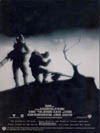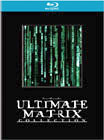
- Film 1: The Matrix
- The Animatrix:
.. - The Second Renaissance
.. - Kid's Story
.. - Program
.. - World Record
.. - Beyond
.. - A Detective Story
.. - Matriculated
.. - Final Flight of the Osiris /
.........Enter the Matrix
- Film 2: The Matrix Reloaded
- Film 3: The Matrix Revolutions
- Return to Source Documentary:
Philosophy and the Matrix

SCIENCE FICTION:
- Doctor Who
- Sliders
- Star Trek:
. - The Original Series (TOS)
. - The Animated Series
. - The Movies
. - The Next Generation (TNG)
. - Deep Space Nine (DS9)
. - Voyager
. - Enterprise
|
The Animatrix:
The Second Renaissance
 |
 |
 |
DVD NTSC
Region 1
10-disc box set
for North America
 U.S.
U.S.

 U.S.
U.S.

 Canada
Canada

|
DVD PAL
Region 2
10-disc box set
for the U.K.
 U.K.
U.K.

|
|
(The Animatrix, segments 2 & 3)
- story by the brothers Larry and Andy Wachowski
- written and directed by Mahiro Maeda
- produced by Larry and Andy Wachowski, Michael Arias,
Eiko Tanaka, Hiroaki Takeuchi
- music by Don Davis
- 2 episodes, each being 9 min. action plus 8 min. credits
|
Story: This two-part animated documentary
found in Zion's computer archive
attempts to chronicle the trilogy's backstory
of the fall of man and
the rise of the artificial intelligence that
enslaved him within the Matrix.
|
|
In-Depth Analysis Review
by Martin Izsak
|
|
WARNING: This review contains "SPOILERS", and is intended for
those who have already seen the story.
|
In our attempt to follow the Matrix saga chronologically, it is necessary
to detour into "The Animatrix" at this point. This is a bizarre collection
of animated story vignettes based on the franchise, and one that only truly
feels worthwhile when it warms up a bit in the second half of its
"9-episode season".
However, a true chronology pretty much means that the first segment should
come last, so we're going to skip ahead to the next two segments,
"The Second Renaissance, Parts 1 & 2". I've no idea why they didn't just
make one long episode out of it, as I don't think they ever broadcast this
anywhere. Since this is all backstory to the entire trilogy, I suppose one
could argue that it should come before "The Matrix", but I assure you, you
don't want anyone's first impressions coming from this pseudo-documentary.
The first feature film needs to come first. If we figure that this documentary
was one of the first things Neo looked at when he came to Zion after the first film,
we'll probably be on the safest, most accurate, and most structurally satisfying ground
possible.
"The Second Renaissance" is probably my least favourite of all the segments
of the Animatrix. Although capable of mesmerizing with some intriguing images,
it also repeatedly indulges in distastefully horrific images as well, while failing
to have enough of a point to them to make them worthwhile. Philosophical commentator Ken Wilber
loves to plunder this story as a source of clues to help make sense of the entire 3-film-plus
saga, particularly in how we should look beyond the enemy-centered paradigm presented
in film 1. But there is a great lack of depth to the motivations for any action
seen in this tale. The two words of narration that Wilber loves to quote are trite,
and don't really seem to describe the events of this film nor a plausible set-up
for the premise of the trilogy. The fact that we have no main character here and
only a very bland soul-less narrator in the story certainly doesn't help true motivation
to find a voice.
But perhaps the biggest miscalculation of this piece is in all the numerous
scenes of victimhood vs. senseless violence. I don't know if it's supposed to be
enough to show the roles reverse several times, now man does it to machine,
now machine does it to man. In my mind, it mostly just doesn't ring true for
man or machine, and we're not digging deep enough into either psyche to get
any kind of understanding that I can believe in. In fact, the common dynamic
behind this kind of thing in film is that it signals the end of a search
for understanding when the victim is portrayed as innocent (not looking at
what he or she may have done or emoted to draw such an experience in) and the
perpetrator is portrayed as evil (not looking at what grievances or issues
may have existed to bring it on). As presented here, the motivations for both
man and machine are pretty hollow.
In sci-fi, we've long been inundated with machine intelligence that suddenly
becomes... not just self-aware which would be a fair stretch, but also full of
fear applied to a sense of self-preservation. If that crap isn't programmed in by living
creatures in the first place, it's surely not going to spontaneously manifest with
the same evolved hormonal potency that it does in us humans.
And does man himself ever really partake in the kind of violence we see here,
generalized over entire populations, escalating uncontrollably to unbelievable
extremes? These aspects of "The Second Renaissance" make it feel instinctively
more like propaganda to me than fact. Add on top all of the general science problems
of the backstory, such as how man would think that the machines are more dependent
on the sun than he is, or how the machines would think that man is the next best
power source on the planet in the absence of direct sunlight. Where does man's
food come from? You can't just keep recycling him back upon himself as food,
as the energy would be quickly depleted. He is not a magical perpetual
motion machine. Launch some solar satellites up above the scorched cloud layer
for God's sake.
In the midst of this mess, there are a few tidbits that I liked. Firstly,
that the machines built their own city/nation, which was interesting. Secondly,
that this nation turned out to be a powerhouse within the systems of money and
economy that man had built, until no human corporation could compete with that of
the machines. NOW, you've got a shift of power in a dramatic turn that I can totally
believe in. Of course, humans could learn to live perfectly well without money,
or with a different system of it, but it doesn't seem to be an easy thing for us
to grow out of, or even be aware of. Can we think outside that box?
Our article on
Monetary Reform can probably kick-start some examinations
of our issues there.
In fact, there are so many ways to support the economic turn in
"The Second Renaissance" with completely other scenes, you really have to question why
we got the ones we did, or how such sources of poor content were chosen.
The producers acknowledge how depressing and cruel some scenes of this movie are.
So why make them? Surely there are better things to be making films of, better
images to be focusing our awareness on. This isn't a segment that an audience
should or will want to view often.
Although I believe the director is intelligent and has a noble aim in mind,
we see him here commit the same mistake as most of the major news media
in distracting the masses with tragedy. One ends up with the false impression
that only acts of cruelty were important to the setting up of the Matrix,
which in the end feels exceedingly hollow.
The human mind must act as a kind of filter simply because there is too much
information out there for us to process it all. Even the criteria of focusing on
what is "real" will leave us with too much information to process, and so we must
narrow it down even more. I have taken to heart firstly the criteria that information
should be "useful" and/or "helpful" and/or "empowering me to be the best person I can be".
And under that test, negative imagery fails miserably. It tends to make me stop all
activity and curl up in a ball, should I take it to heart, because I know that stopping
and re-grouping are preferable to lashing out in anger which does more to perpetuate
negative cycles than to transmute them. Thus the lessons learned from negative sources are
minimal compared with the direction one can get out of positive sources. If anything,
a negative image
only deserves to be looked at once, while a positive one deserves many many repeat viewings.
Most news media fails this and tends to lean towards distracting tragedy rather than
investigating any real cause that might make its advertising sponsors look bad.
"The Second Renaissance" seems to be trying to follow suit.
While I sympathize with the filmmakers' end goals, I feel very strongly that
the various means they are using to try to reach those goals are rubbish.
The credits for the Animatrix are a bit of a pain - basically one great long
boring 8-minute movie-style trawl. It's particularly a pain if you watch the segments
individually, as the exact same overly long credit sequence is patched in after each
and every one, just about doubling its running time, and with dialogue from
segments you haven't seen yet dubbed randomly over the music, threatening to spoil
future episodes. This, along with the wildly variable lengths of the other segments,
really drives home the absurdity of splitting "The Second Renaissance" into two segments.
I wish each segment had had its own short-and-to-the-point credit sequence.
Well, this is mostly an ugly double helping of the Animatrix that somehow
never acquires any sort of dramatic structure. It ambles along for a while,
muddling through the backstory, and then just ends all of a sudden. Very weird.
I suggest moving quickly on past this one, because there is much better stuff in
store ahead.
|





 U.S.
U.S. Canada
Canada U.K.
U.K.
 U.S.
U.S.  Canada
Canada 
